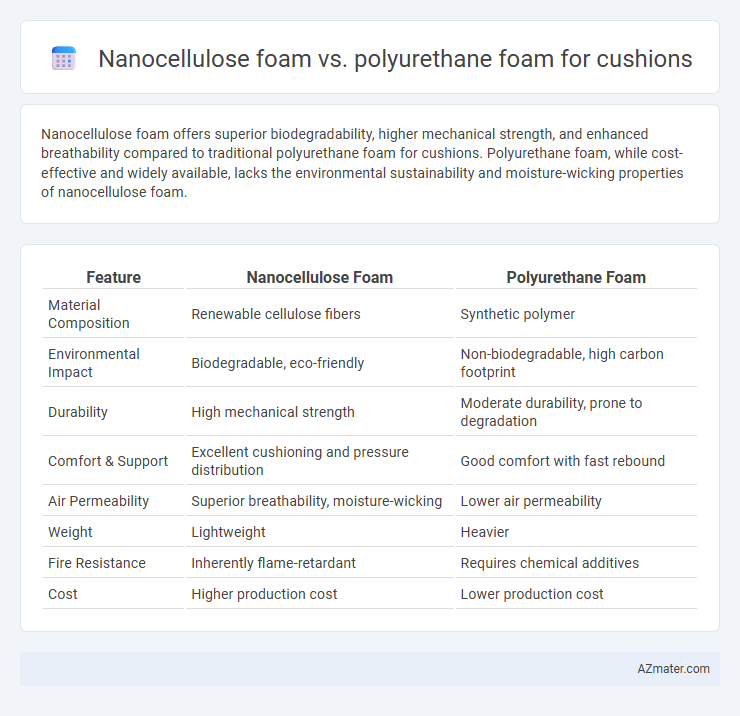Nanocellulose foam offers superior biodegradability, higher mechanical strength, and enhanced breathability compared to traditional polyurethane foam for cushions. Polyurethane foam, while cost-effective and widely available, lacks the environmental sustainability and moisture-wicking properties of nanocellulose foam.
Table of Comparison
| Feature | Nanocellulose Foam | Polyurethane Foam |
|---|---|---|
| Material Composition | Renewable cellulose fibers | Synthetic polymer |
| Environmental Impact | Biodegradable, eco-friendly | Non-biodegradable, high carbon footprint |
| Durability | High mechanical strength | Moderate durability, prone to degradation |
| Comfort & Support | Excellent cushioning and pressure distribution | Good comfort with fast rebound |
| Air Permeability | Superior breathability, moisture-wicking | Lower air permeability |
| Weight | Lightweight | Heavier |
| Fire Resistance | Inherently flame-retardant | Requires chemical additives |
| Cost | Higher production cost | Lower production cost |
Introduction to Cushion Foams
Nanocellulose foam and polyurethane foam are widely used materials in cushion manufacturing due to their unique structural properties. Nanocellulose foam offers high strength-to-weight ratio, biodegradability, and excellent moisture resistance, making it an eco-friendly alternative to traditional polyurethane foam. Polyurethane foam remains popular for its versatile density options, superior cushioning comfort, and cost-effectiveness in various applications from automotive seating to furniture upholstery.
What is Nanocellulose Foam?
Nanocellulose foam is an innovative, lightweight material derived from cellulose fibers sourced from plants, offering exceptional strength and biodegradability compared to traditional polyurethane foam. This foam exhibits excellent cushioning properties with high resilience and breathability, making it ideal for sustainable cushion applications. Unlike polyurethane foam, nanocellulose foam is non-toxic, renewable, and environmentally friendly, supporting eco-conscious manufacturing and disposal practices.
What is Polyurethane Foam?
Polyurethane foam is a versatile synthetic material widely used in cushioning due to its durability, flexibility, and excellent shock absorption properties. It is produced through the chemical reaction of diisocyanates and polyols, resulting in a lightweight foam structure that offers superior comfort and support. Compared to nanocellulose foam, polyurethane foam typically provides more consistent resilience and is cost-effective for mass production in cushions.
Material Properties Comparison
Nanocellulose foam exhibits superior biodegradability and higher tensile strength compared to traditional polyurethane foam, making it an environmentally friendly choice for cushions. Its excellent moisture-wicking and thermal insulation properties enhance comfort and durability, whereas polyurethane foam is prone to off-gassing and deformation over time. Nanocellulose foam's lightweight structure combined with its high resilience offers improved cushioning performance without compromising sustainability.
Comfort and Support Analysis
Nanocellulose foam offers superior breathability and moisture-wicking properties compared to polyurethane foam, enhancing comfort by regulating temperature and reducing sweat buildup. Its high tensile strength and resilience provide consistent support that adapts to body contours, minimizing pressure points for prolonged seating comfort. Polyurethane foam, while widely used for cushioning, tends to degrade faster and retain heat, which may compromise long-term comfort and support.
Environmental Impact and Sustainability
Nanocellulose foam offers a highly sustainable alternative to polyurethane foam, as it is derived from renewable cellulose fibers and is biodegradable, significantly reducing environmental pollution. In contrast, polyurethane foam relies on petrochemicals, involves energy-intensive production processes, and generates non-biodegradable waste that contributes to landfill accumulation and microplastic pollution. Choosing nanocellulose foam for cushions supports reduced carbon footprint, lower toxicity, and enhanced ecological balance through its renewable sourcing and end-of-life compostability.
Durability and Lifespan
Nanocellulose foam offers superior durability compared to polyurethane foam due to its high tensile strength and resistance to compression over time, making it ideal for long-lasting cushions. Unlike polyurethane foam, which tends to degrade and lose resilience within 5-10 years, nanocellulose foam maintains structural integrity and comfort for extended periods, often beyond 15 years. This enhanced lifespan and consistent performance make nanocellulose foam a sustainable and reliable choice for durable cushioning applications.
Cost and Production Efficiency
Nanocellulose foam offers a sustainable alternative to polyurethane foam with higher biodegradability but often involves higher raw material costs and slower production rates due to complex extraction and processing methods. Polyurethane foam remains cost-effective with established, large-scale manufacturing processes that enable rapid production and lower unit costs. The trade-off between nanocellulose foam's eco-friendliness and polyurethane foam's cost-efficient mass production is critical in selecting cushioning materials for commercial applications.
Applications in Cushion Manufacturing
Nanocellulose foam offers superior biodegradability and lightweight properties compared to traditional polyurethane foam, making it ideal for eco-friendly cushion manufacturing. Its high mechanical strength and excellent moisture resistance enhance durability and comfort in furniture and automotive seating applications. Polyurethane foam remains popular due to its cost-effectiveness and versatile cushioning performance, but growing demand for sustainable materials is driving increased adoption of nanocellulose foam in the cushion industry.
Future Prospects and Innovations
Nanocellulose foam exhibits promising future prospects as an eco-friendly alternative to polyurethane foam, leveraging its biodegradability and renewable nature to reduce environmental impact in cushion manufacturing. Innovations in nanocellulose foam include enhanced mechanical strength, improved thermal insulation, and integration with smart materials for responsive cushioning solutions. Research advancements aim to scale production cost-effectively, enabling broader adoption in automotive, furniture, and wearable technology industries.

Infographic: Nanocellulose foam vs Polyurethane foam for Cushion
 azmater.com
azmater.com